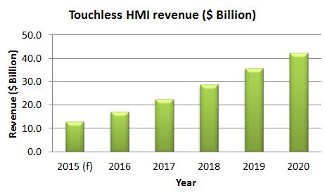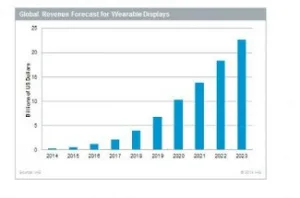CE markets are always changing and everyone wants to stay ahead of what is going on. This leads to many market reviews and market forecasts of products that have not even been developed and appears to be especially true for the developing wearables market. Market research also plays an important role in the development of new products such as smartglasses, smartwatches, smartrings and, or so it would seem, everything else labelled smart.
Market researchers analyze the product features, component capabilities, supply chain and consumer interest among many other aspects of new devices, though this is not foolproof and often the analysis turns out to be wrong. Nevertheless, the many reports looked at together may reveal the overall trend and potential market acceptance. For example, consider the introduction of tablets. The market analysts were pretty much divided into the believers and the non-believers and, of course, only one camp can be right.
As has been reported recently (Display Monitor Vol 21 No 39), Juniper Research expects 116 million units of smart devices will be sold in 2017. A strong growth with still a relatively low attachment rate of only 5% to smartphones. Overall this seems to show a cautiously optimistic outlook in this market.
Nanomarkets released a forecast for smartglasses that suggests that the components used in such devices will reach a sales volume of $3.2 billion by 2019. The optical components such as mirrors, lightguides and microdisplays will make up a $1.9 billion market. If we assume that by 2019 the cost of smartglasses will have reached the $200 to $300 level, components should not exceed $100 to $150 per device. This would equate to an estimate of about 20 to 30 million devices in 2019.
As NanoMarkets “see these devices as potentially emerging as a mass market item with potential for replacing smart phones as the main mobile computing and communications platform over the next decade”, one could say that they are very bullish about this technology. The analysts see smartglasses as a step towards an advanced human-computer interface developing in the coming decade. If this would lead indeed to real augmented reality by transferring information to the brain without using the visual input channel (aka our eyes), the best or worst science fiction ideas may become true. Of course optical component wouldn’t be needed then, so we presume that NanoMarkets doesn’t see this happening in the forecast period.
IHS sees the flexible OLED display market benefiting from the wearable device explosion by selling more and more full color flexible OLED displays in this market. According to its forecast, the display sales will grow from 54 displays this year to 800 million units by 2023. The sales development is shown below.
IHS’s forecast is showing exponential growth in coming years. The market will reach several billion dollar revenue after 2017, in other words drivers will be products that aren’t even being thought of today. The company’s market focus is more driven by the OLED flexible display aspect and less by the wearable device aspect.
Touch Display Research is taking a look at the development of the “Touchless Human-Machine-Interaction Market” in its newest report. As many established companies are entering this field either through research or the acquisition of start up companies, this field will enter many applications including wearable devices. The report looks at automotive, game console, TV, mobile phone/tablet, NB/desktop/AIO PC, wearable device, home/building automation and other applications. The resulting forecast includes wearbale devices, but goes far beyond this field.
As we can see, this growth pattern is much more linear compared to the growth expectations of IHS for flexible displays.
Overall the market analysts seem to have identified the next growth engines for the near future in the CE world. – Norbert Hildebrand


